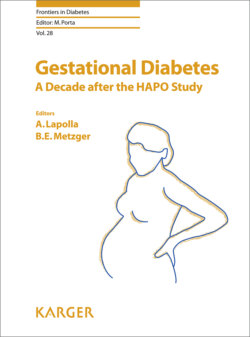Читать книгу Gestational Diabetes - Группа авторов - Страница 38
На сайте Литреса книга снята с продажи.
Mechanisms Underlying Effects of Obesity in Pregnancy
ОглавлениеInsulin sensitivity. Overweight and obesity outside pregnancy are associated with decreased insulin sensitivity or higher insulin resistance. Therefore, women with prepregnancy overweight and obesity start pregnancy in less insulin-sensitive state than women who are lean prior to pregnancy. However, the pregnancy-induced physiological decrease in insulin sensitivity increases the demands on the pancreatic β-cells to secrete insulin in overweight and obese women. For many overweight and obese women, the excess capacity of the pancreatic β-cells remains sufficient to control blood glucose levels even though mild hyperglycemia is noted with continuous glucose monitoring [29]. However, in those where that capacity is impaired, overt hyperglycemia occurs leading to the diagnosis of GDM.
The lower insulin sensitivity may be partially due to preexisting changes to the insulin signaling pathway. In obesity, the lower levels of insulin sensitivity also lead to increased availability of lipids due to less insulin-induced inhibition of lipolysis. This is reflected in higher circulating lipids, including triglycerides and VLDL cholesterol, in women with prepregnancy obesity even in the absence of GDM [30, 31]. In obesity, hepatic insulin sensitivity is further reduced compared with lean pregnant women [32]. In adipose tissue, adipocyte size is negatively correlated with insulin sensitivity due to a lower density of insulin receptors in the enlarged adipocyte, which causes lower insulin sensitivity even in the absence of hyperglycemia [33]. The expansion in insulin secretion from pancreatic β-cells is also reduced in obese normoglycemic women as compared to lean women; this likely reflects the greater decrease in insulin sensitivity in lean women who therefore need to compensate by increasing insulin secretion more [34]. In contrast to lean women, obese women are in a state of lipid degradation throughout the duration of pregnancy, which likely is a reflection on their lower initial levels of insulin sensitivity.
Lipid metabolism. Furthermore, genes involved in fatty acid metabolism display decreased gene expression in adipose tissue from obese women independent of their glycemic status [35]. The altered genes range from those that encode proteins regulating lipolysis but also fatty acid uptake and lipolysis. Given that inhibition of lipolysis by insulin through inhibition of hormone-sensitive lipase is less effective in late pregnancy, prepregnancy obesity with its associated decrease in insulin sensitivity also in adipose tissue may exacerbate this. The increased availability of metabolic fuels in the maternal circulation in obesity, including glucose and lipids, is likely to contribute to increased nutrient availability to the growing fetus and thereby to the higher likelihood of a baby born LGA in overweight and obese mothers.
Inflammation. The low-grade inflammation state of pregnancy is exacerbated in obesity given the preexisting state of low-grade inflammation that is due to higher fat mass. Obese pregnant women have increased IL-6 levels compared with lean pregnant women, which is independent of glycemic status [36]. The combination of obesity and GDM has been reported to exacerbate the inflammatory profile in some but not all studies [36]. These conflicting reports are likely due to differences in timing of sampling and heterogeneous populations with regard to the level of obesity and the severity of GDM. Global gene expression studies of placentas from overweight women with GDM have reported higher levels of expression of genes encoding proteins associated with inflammation and lipid metabolism but not glucose metabolism [37]. In obese pregnancy, the placenta and the adipose tissue both regulate maternal metabolism although their regulation is not coordinated. Adipose tissue, especially visceral white adipose tissue, also actively secretes inflammatory mediators such as cytokines as well as adipokines. More adipose tissue is therefore likely to result in higher circulating levels of inflammatory mediators. In obesity, circulating TNFα and IL-6 levels are increased, which may originate from white adipose tissue [38].
Fig. 1. Mechanisms underlying the association of obesity per se (without accompanying hyperglycemia) with excess fetal growth.
